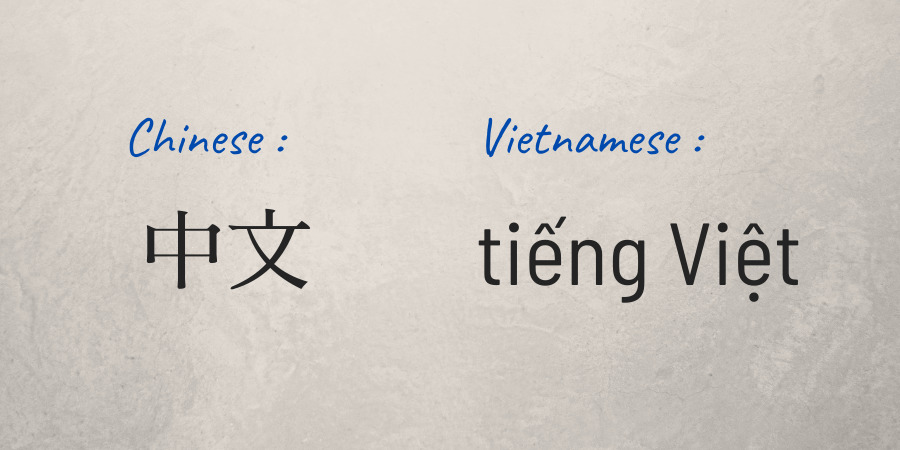Is Vietnamese similar to Chinese?
Despite sharing some history, the Vietnamese language and Chinese languages have developed in vastly different ways. An average speaker of either language won't understand the other language at all.

left: «Chinese» written in Chinese
right: «Vietnamese» written in Vietnamese
Nevertheless, there are still fascinating similarities in tones and vocabularies that are frequently detected by those who speak both languages.
The linkages between Chinese and Vietnamese reveal the complex ways in which languages develop over human history.
Origins of Vietnamese and Chinese languages
Chinese is the oldest written language still in use today. It's spoken across the geographic area of modern China and has up to 10 different regional dialects.
While these dialects are mutually unintelligible, speakers can still understand each other through standardized written Chinese. The most common dialects are:
- Mandarin (with more than 70% of the Chinese population as speakers)
- Cantonese
- Hunanese.
Vietnamese, on the other hand, is the native language of the majority of the population in Vietnam. It belongs to the Mon-Khmer branch of the Austro-Asiatic language family, which also includes some of the major languages of Southeast Asia, like:
- Khmer
- Muong
- Mon
There's one single dialect and one common script used across Vietnam.
Modern Vietnamese still has significant Chinese influence through a history of colonialism:
- China conquered Vietnam (which was called Nam Viet) for the first time in 111 BC and ruled it for 1000 years.
- One of its major influences was on the Vietnamese language.
- In the 10th century, Vietnam adopted the Chinese script to write down spoken Vietnamese.
Vietnam continued to fall under Chinese empire rule several times until the modern era. Over time, aspects of Chinese culture, knowledge, and languages were adopted as part of Vietnamese culture.
Later during Vietnam's era of French colonialism, a Latin script system for Vietnamese was developed by Jesuit Catholic missionaries beginning in the 17th century.
Eventually, Vietnam adopted the Latin script over the Chinese script, which made learning written Vietnamese much simpler for later generations.
Are Vietnamese and Chinese mutually intelligible?
Vietnamese and any Chinese dialect are not mutually intelligible. Despite the adoption of Chinese script in Vietnam in the past, they are still two completely different languages in two different families.
Should you learn Vietnamese or Chinese first as an English speaker?
If based purely on ease of learning, an English speaker will have an easier time learning Vietnamese because it also uses the Latin alphabet.
Nevertheless, Vietnamese is still difficult for English speakers compared to other languages with Latin alphabets.
In fact, Chinese and Vietnamese are both among the hardest languages for English speakers to learn.
The foreign service institute (FSI) classifies Vietnamese as a category 3 language. The categories go from 1 to 4 with 4 being the hardest.
It is estimated that it will take at least 1100 class hours (44 weeks) for an English speaker to learn Vietnamese.
On the other hand, an English speaker will take at least 2200 class hours (88 weeks) to learn either Mandarin or Cantonese. These are classified as category 4 languages (the hardest category for English speakers to learn)
However, many still opt to learn Chinese because it gives them access to at least a billion native speakers, if not counting other foreign learners.
You want to consider plenty of other reasons before choosing which of the two languages to learn. Despite being the more difficult language, there's a lot more material for learning Chinese than Vietnamese out there.
You also want to consider the personal benefits you get when learning each language. For instance, if your job requires you to work with a lot of Vietnamese people, definitely opt for learning Vietnamese, and vice versa.
Similarities between Vietnamese and Chinese
Vietnamese and Chinese are tonal languages
Both Vietnamese and Chinese (Mandarin and Cantonese) are tonal languages, meaning that changing the pitch of a word will change its meaning. This is why the two languages can sound similar to non-speakers.
Is Cantonese or Mandarin more similar to Vietnamese?
Because of geographical proximity, Cantonese, which is spoken in Southern China near the border with Vietnam, sounds more similar to Vietnamese than Mandarin. Both Cantonese and Vietnamese have six tones, while Mandarin has four.
There are many Chinese loan words in Vietnamese
There's a significant number of Vietnamese words with Chinese origins, with the highest estimates at up to 70% of Vietnamese vocabulary. Another study of 1500 words in 2007 lowered that figure to 27%, but its methodology did not include grammatical vocabularies, names, or regional vocabs.
A more comprehensive future study will probably show a number somewhere between 27% and 70%. Needless to say, any number within the range shows a significant influence of Chinese over Vietnamese.
Some Vietnamese dictionaries still differentiate between native Vietnamese words (từ thuần Việt) and Chinese-Vietnamese or Sino-Vietnamese words (từ Hán Việt).
Sino-Vietnamese words are much more prevalent in formal speeches and writing, while native Vietnamese is more prevalent in casual conversations.
Below are some common words in Vietnamese with Chinese origin:
- thông minh 聰明 - Intelligent
- má 媽 - mom
- ba 爸 - dad
- thiên sứ 天使 - angel
- minh bạch 明白 - transparent/clear
- lao động 勞動 - labor
- nguy hiểm 危險 - dangerous
- hành lý 行 李 - luggage
- giày 鞋 - shoe
- ảo tượng 幻象 - illusion
While these Vietnamese and Chinese equivalences share similar origins, they won't sound much similar to the untrained ears. As such, only people who know both languages well can determine words with common origins.
NamesMost names and name translations in Vietnamese have Chinese origins. Sino-Vietnamese names are derived from the characteristics of the person or place. For instance:
Baby Names:
- Bảo 寶, meaning 'treasure, jewel.' Indicate that the parents want to nurture and treasure this baby.
- Châu 珠, also means 'treasure, jewel' or 'gem.'
- Minh 明, meaning 'bright.' For parents who want a baby who is smart and witty.
- Hùng 雄, a masculine name meaning 'brave' or 'manly.'
- Hương 香, a feminine name meaning 'flower fragrance.' For parents who desire a sweet and feminine child.
- Nguyệt 月, meaning 'moon." Similar meaning to 'bright.'
- Vinh 榮, meaning 'glory.' For parents who wish their child will succeed in life.
When it comes to proper nouns, like names of geographic locations or attractions, there is a mix of names based on the location's characteristics along with names based on Chinese transliteration.
Name of Countries and Cities based on characteristics:
- Hoa Kỳ 花旗, 'The United States', and directly translates to 'flower flag'
- Trung Quốc 中國, 'China', and directly translates to 'The Middle Kingdom', which reflects the old belief that the Chinese empire was the center of the world
- Triều Tiên 조선, 'North Korea', and directly translates to 'land of beautiful mornings'
- Thiên Trúc 天竺, the old name for 'India', and directly translates to 'land of the heaven,' which refers to the origin of Buddhism in India
- Hoa Thịnh Đốn 華盛頓, the old name for 'Washington DC', and directly translates to 'blooming flower city'
- Hương Cảng, ‘Hong Kong’, and directly translates to ‘fragrant port’
Name of Countries and Cities based on old Chinese transliteration:
- Nữu Ước 紐約, 'New York'
- Hy Lạp 希腊, 'Greece', based on the Chinese transliteration of Hellas, which is the country's name is Greek
- Ý (short for Ý Đại Lợi) 意大利. 'Italy'
- Phi Luật Tân 菲律賓, ‘Philippines’
- Tân Gia Ba 新加坡, ‘Singapore’
Nowadays, with the prevalence of English globally, people may use the English words for a name instead of their Chinese or Sino-Vietnamese versions.
Differences between Vietnamese and Chinese
Alphabet and Writing
As previously explained, Vietnamese intellectuals abandoned the Chinese script and opted for the Latin script in the early 20th century. Some argue that this adoption helped Vietnam increase its literacy rate in the 20th century, but there's been no proof of this claim.
Nevertheless, having a Latin alphabet drastically quickened the process of learning Vietnamese. In the past, people had to learn Chinese first to be able to write Vietnamese in the Chinese script.
This is because Chinese essentially has no alphabet but has a series of characters that either look like what it is describing, combine sound and meaning, or combine together in special ways. Nowadays, Chinese students will know at least 3000 characters before high school.
The differences between the two writing systems become magnified when it comes to typing. The modern keyboard was made specifically for the Latin alphabet, so Chinese speakers faced a massive barrier to computers and the internet.
Chinese developers had to create the Pinyin system, which uses Latin characters to look up Chinese words based on sound, to help Chinese speakers use computers.
Sentence structuresBoth Chinese and Vietnamese have simple sentences in the form of subject + verb + object. However, different types of sentences have unique variations.
Sentences with location:
- For Vietnamese: Subject + Verb + Object + Location
- For Chinese: Subject + Location + Verb + Object
Sentences with time duration:
- For Vietnamese: Subject + Verb + Object + Time duration
- For Chinese: Subject + Verb + Object + Verb + Time duration
Conclusion
Foreigners who hear the varying tones of Vietnamese and Chinese will wonder if the two languages are similar. It turns out, while the two languages share a lot of history, it's difficult for a speaker of either to understand the other language.
No matter which of the two languages you want to learn, you're on for a fascinating journey into culture and history.
